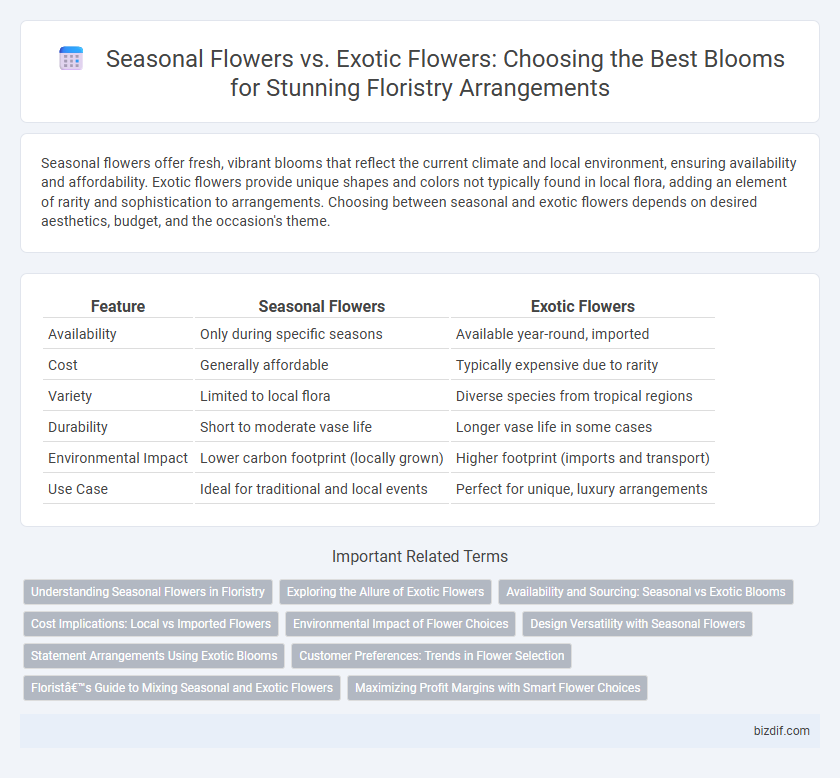Seasonal flowers offer fresh, vibrant blooms that reflect the current climate and local environment, ensuring availability and affordability. Exotic flowers provide unique shapes and colors not typically found in local flora, adding an element of rarity and sophistication to arrangements. Choosing between seasonal and exotic flowers depends on desired aesthetics, budget, and the occasion's theme.
Table of Comparison
| Feature | Seasonal Flowers | Exotic Flowers |
|---|---|---|
| Availability | Only during specific seasons | Available year-round, imported |
| Cost | Generally affordable | Typically expensive due to rarity |
| Variety | Limited to local flora | Diverse species from tropical regions |
| Durability | Short to moderate vase life | Longer vase life in some cases |
| Environmental Impact | Lower carbon footprint (locally grown) | Higher footprint (imports and transport) |
| Use Case | Ideal for traditional and local events | Perfect for unique, luxury arrangements |
Understanding Seasonal Flowers in Floristry
Seasonal flowers in floristry refer to blooms that naturally flourish during specific times of the year, ensuring peak freshness and vibrant colors. Utilizing seasonal flowers like tulips in spring or chrysanthemums in autumn supports sustainable practices and often reduces costs due to local availability. Florists prioritize these blooms for their reliability, longer vase life, and alignment with natural growth cycles, enhancing the overall quality of floral arrangements.
Exploring the Allure of Exotic Flowers
Exotic flowers captivate with their vibrant colors, unique shapes, and rare origins, making them a prized choice in floristry for creating standout arrangements. Unlike seasonal flowers, which are regionally and temporally limited, exotic blooms offer a year-round availability and an element of surprise that elevates the aesthetic appeal. Their diversity, from striking orchids to bold proteas, provides endless creative possibilities for florists seeking to craft mesmerizing and distinctive floral designs.
Availability and Sourcing: Seasonal vs Exotic Blooms
Seasonal flowers are typically sourced locally and available during specific times of the year, ensuring freshness and supporting regional agriculture. Exotic flowers often require international importation, longer supply chains, and specialized handling to maintain quality during transit. The contrast in availability reflects the sustainability and cost differences between readily accessible seasonal blooms and the unique, rare nature of exotic flowers.
Cost Implications: Local vs Imported Flowers
Seasonal flowers, sourced locally, typically offer lower costs due to reduced transportation and storage expenses, supporting sustainability and fresher blooms. Exotic flowers, often imported from distant regions, incur higher prices reflecting complex logistics, customs fees, and extended supply chains. Florists balance these factors by combining local seasonal blooms with select exotic varieties to optimize both cost-efficiency and unique floral designs.
Environmental Impact of Flower Choices
Seasonal flowers typically have a lower environmental impact due to their natural growth cycles and local availability, reducing the need for energy-intensive greenhouses and long-distance transportation. Exotic flowers often require significant resources for cultivation and importation, including higher water usage, pesticide application, and carbon emissions from air freight. Choosing seasonal blooms supports sustainable floristry by minimizing carbon footprints and promoting biodiversity within local ecosystems.
Design Versatility with Seasonal Flowers
Seasonal flowers offer unparalleled design versatility due to their wide availability and variety throughout the year, allowing florists to create fresh and dynamic arrangements that align with current trends and occasions. Their natural abundance and diverse colors enable easy customization and innovative combinations, enhancing both texture and visual appeal in floral designs. In contrast, exotic flowers, while striking, often limit design flexibility due to higher costs and limited seasonal availability.
Statement Arrangements Using Exotic Blooms
Statement arrangements using exotic blooms showcase rare, vibrant flowers like proteas, bird of paradise, and anthuriums, adding a dramatic flair unmatched by seasonal varieties. These exotic flowers offer unique textures and bold colors that create captivating focal points in floral designs, elevating any space or event. Their rarity and distinctive appearance make them ideal for high-impact arrangements that leave a lasting impression.
Customer Preferences: Trends in Flower Selection
Customers increasingly favor seasonal flowers for their natural freshness, affordability, and environmental sustainability, driving higher demand in local markets. Exotic flowers attract niche buyers seeking unique, vibrant arrangements that showcase rarity and luxury. Trends indicate a balance where consumers blend seasonal blooms with exotic accents to create personalized floral designs reflecting both tradition and innovation.
Florist’s Guide to Mixing Seasonal and Exotic Flowers
Florists enhance floral arrangements by skillfully combining seasonal flowers like tulips, daffodils, and chrysanthemums with exotic blooms such as orchids, proteas, and bird-of-paradise. Seasonal flowers provide freshness, cost-efficiency, and local appeal, while exotic flowers introduce unique shapes, vibrant colors, and a touch of luxury. Balancing these elements allows florists to create visually stunning bouquets that cater to diverse customer preferences and optimize inventory management.
Maximizing Profit Margins with Smart Flower Choices
Seasonal flowers offer higher profit margins due to lower costs and greater availability, making them ideal for florists aiming to maximize revenue. Exotic flowers, while more expensive and less predictable in supply, can command premium prices that attract niche customers seeking unique arrangements. Balancing the use of cost-effective seasonal blooms with strategically selected exotic varieties enhances overall profitability by meeting diverse market demands.
Seasonal Flowers vs Exotic Flowers Infographic

 bizdif.com
bizdif.com